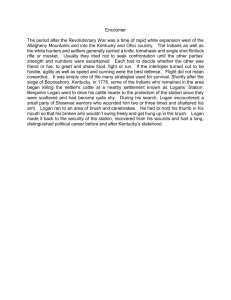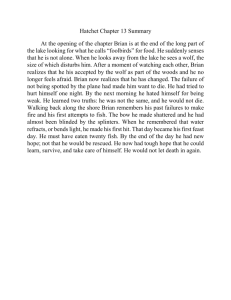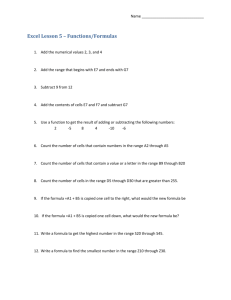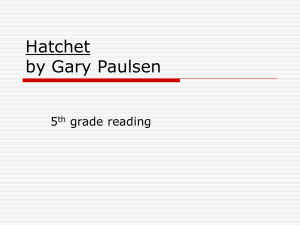task environment - School of Computer Science
advertisement
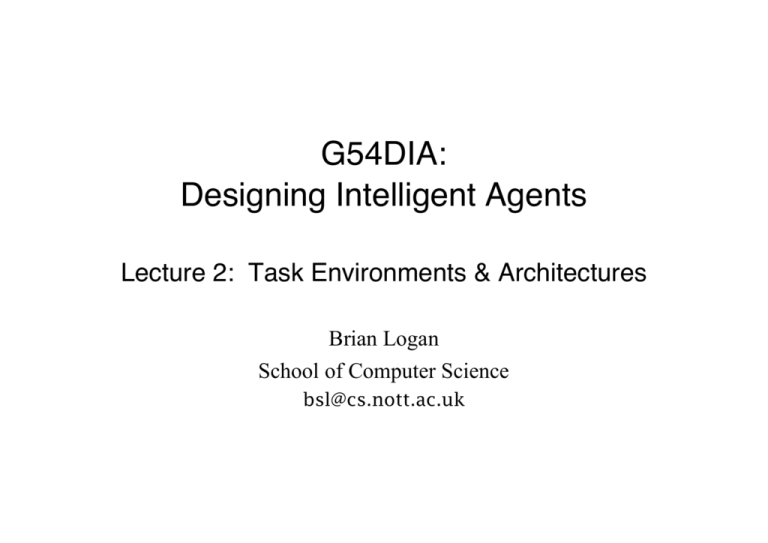
G54DIA: Designing Intelligent Agents Lecture 2: Task Environments & Architectures" Brian Logan School of Computer Science bsl@cs.nott.ac.uk Outline of this lecture" • programming agents & the role of agent architectures • properties of task environments • examples: – MAXIMS: filtering email – Fred & Ginger: cooperative robotics • relationship between task environment and architecture © Brian Logan 2013 G54DIA Lecture 2: Task Environments 2 Designing intelligent agents" • an agent operates in a task environment: – task: the goal(s) the agent is trying to achieve – environment: that part of the real world or a computational system ‘inhabited’ by the agent • agent obtains information about the environment in the form of percepts • agent changes the environment by performing actions to achieve its goals © Brian Logan 2013 G54DIA Lecture 2: Task Environments 3 The task environment defines the problem" • we can sometimes manipulate the task and/or environment to make things easier Task" results" • e.g., increasing the contrast of objects to make things easier for a robot’s cameras goals" Agent" percepts" • however the task environment is usually given © Brian Logan 2013 actions" Environment" G54DIA Lecture 2: Task Environments 4 Specifying an agent to solve the problem" • the behaviour of an agent is described by an agent function (action selection function) which maps a goal and sequence of percepts to an action (and possibly results) • agent programming is conventionally conceived as the problem of synthesising an agent function • e.g., Russell & Norvig (2003) claim that: “the job of AI is to design the agent program that implements the agent function mapping percepts to actions” • this is a very difficult problem © Brian Logan 2013 G54DIA Lecture 2: Task Environments 5 R & N view of an agent" • program: implements the agent function mapping from goals & percepts to actions (& results) • state: includes all the internal representations on which the agent program operates • architecture: computing device with sensors and actuators that runs the agent program © Brian Logan 2013 Task" results" goals" Program" State" Architecture" percepts" actions" Environment" G54DIA Lecture 2: Task Environments 6 Agent architectures" • one way of making the agent programming problem more tractable is make use of the notion of an agent architecture • the notion of an “agent architecture” is ubiquitous in the agent literature but is not well analysed • often discussed in the context of an agent programming language or platform • largely ignored by agent text books, e.g. Russell & Norvig (2003) view the architecture as simply “some sort of computing device with physical sensors and actuators” © Brian Logan 2013 G54DIA Lecture 2: Task Environments 7 The architecture as a virtual machine" • the architecture defines a (real or virtual) machine which runs the agent program • defines the atomic operations of the agent program and implicitly determines the components of the agent • determines which operations happen automatically, without the agent program having to do anything • e.g., the interaction between memory, learning and reasoning • an architecture constrains kinds of agent programs we can write (easily) © Brian Logan 2013 G54DIA Lecture 2: Task Environments 8 Architectural view of an agent" • program: a function mapping from goals & percepts to actions (& results) expressed in terms of virtual machine operations Task" results" Program" • state: the virtual machine representations on which the agent program operates goals" State" Architecture" percepts" • architecture: a virtual machine that runs the agent program and updates the agent state © Brian Logan 2013 actions" Environment" G54DIA Lecture 2: Task Environments 9 Hierarchies of virtual machines" • in many agents we have a whole hierarchy of virtual machines – the agent architecture is usually implemented in terms of a programming language, which in turn is implemented using the instruction set of a particular CPU (or a JVM) – likewise some ‘agent programs’ together with their architecture can implement a new, higher-level architecture (virtual machine) • used without qualification, ‘agent architecture’ means the most abstract architecture or the highest level virtual machine © Brian Logan 2013 G54DIA Lecture 2: Task Environments 10 Software architectures" • this notion of an agent architecture is related to the more general notion of software architecture • software architectures is the “principled study of the large-scale structures of software systems” (Shaw & Clements 2006) • “architecture is concerned with the selection of architectural elements, their interactions, and the constraints on those elements and their interactions necessary to provide a framework in which to satisfy the requirements and serve as a basis for the design” (Perry & Wolf 1992) • standard architectures for many domains and applications, e.g., n-tier client-server architectures, service oriented architectures, etc. © Brian Logan 2013 G54DIA Lecture 2: Task Environments 11 Cognitive architectures" • agent architecture is also related to the notion of a cognitive architecture as used in artificial intelligence and cognitive science • a cognitive architecture is an integrated system capable of supporting intelligence • often used to denote models of human reasoning, e.g., ACT-R, SOAR • in other cases no claims about psychological plausibility are made • in this latter sense, cognitive architecture is more or less synonymous with agent architecture as used here © Brian Logan 2013 G54DIA Lecture 2: Task Environments 12 Properties of architectures" • an agent architecture can be seen as defining a class of agent programs • just as individual agent programs have properties that make them more or less successful in a given task environment • architectures (classes of programs) have higher-level properties that determine their suitability for a task environment • choosing an appropriate architecture can make it much easier to develop an agent program for a particular task environment © Brian Logan 2013 G54DIA Lecture 2: Task Environments 13 Importance of architecture" • focus of this module will mostly be on agent architectures: – what sorts of architectures there are; and – which architectures are appropriate for different tasks and environments • to program an agent which is successful in a given task environment, we must choose an architecture which is appropriate for that task environment © Brian Logan 2013 G54DIA Lecture 2: Task Environments 14 Task environments & architectures" • to choose an architecture which is appropriate for a given task environment we must be able to characterise both task environments and architectures • in this lecture we’ll look at some properties of task environments that have an impact on the choice of architecture • in later lectures we’ll look at properties of agent architectures … © Brian Logan 2013 G54DIA Lecture 2: Task Environments 15 Specifying task & environment" • the task specifies the goals the agent must achieve (and any results required) • the agent (architecture) and environment jointly determine: Task" results" – the information the agent can obtain (percepts) – the actions the agent can perform • decomposition into task and environment is not always obvious © Brian Logan 2013 goals" Architecture" percepts" actions" Environment" G54DIA Lecture 2: Task Environments 16 Specifying the task" • some tasks may come from the agent itself (autonomy) • an agent may generate its own (top-level) goals Task" results" Agent" • e.g., may generate a goal to keep its battery charged • or it may make use of its own results, e.g., in learning goals" percepts" actions" Environment" © Brian Logan 2013 G54DIA Lecture 2: Task Environments 17 Specifying the environment" • similarly, an agent may be part of its own environment • e.g., if it has sensors monitoring its battery level Task" results" Agent" • agent may also form part of the environment of other agents • e.g., in a multi-agent system goals" percepts" actions" Environment" © Brian Logan 2013 G54DIA Lecture 2: Task Environments 18 Task environment classification" • we will classify the agent’s task environment based on: – task: properties of the goals that must be achieved (for simplicity, we assume the task does not require the return of results) – environment: properties of the percepts and actions possible in the environment • the following properties are illustrative only—for particular types of task environments other properties may be more useful • however the approach can be applied to any task environment © Brian Logan 2013 G54DIA Lecture 2: Task Environments 19 Goals and intentional systems" • we focus on the goals that must be achieved to perform the task (toplevel goals), not where the goals come from • we make no assumptions about the agent’s program state or architecture (or any subgoals generated by the agent) • as we’ll see in later lectures, not all agents represent goals explicitly, even though they act in a goal-directed manner • we assume that it is possible to view the agent as an intentional system, i.e., that we can ascribe a set of goals to it which characterise its behaviour © Brian Logan 2013 G54DIA Lecture 2: Task Environments 20 The interaction of agent & environment" • we focus on the means available to achieve the task goals–the percepts and actions available to the agent – different agents in the same environment may have different percepts and actions available to them – e.g., if one agent has fewer sensors than another or if it can perform only a subset of the actions that the other agent can perform • we make no assumptions about how the agent represents information or chooses actions © Brian Logan 2013 G54DIA Lecture 2: Task Environments 21 Properties of the task" • type of goal: a goal to achieve a particular state in the environment is termed an achievement goal; a goal to maintain or preserve a state in the environment is termed a maintenance goal • number of goals: if the agent must achieve multiple goals in parallel, we say the agent has multiple goals, otherwise it has a single goal • commitment to goals: if a goal is only abandoned when it is achieved we say the agent is strongly committed to its goal(s); otherwise it is only weakly committed • utilities of goals: if the reward for achieving each goal is the same, we say the agent’s goals have equal utility; otherwise its goals have differing utilities • constraints on how goals are achieved: e.g., deadlines, resource bounds © Brian Logan 2013 G54DIA Lecture 2: Task Environments 22 Properties of the environment (percepts)" • discrete / continuous: if there are a limited number of distinct, clearly defined, states of the environment, the environment is discrete; otherwise it is continuous • observable / partially observable: if it is possible to determine the complete state of the environment at each time point from the percepts it is observable; otherwise it is only partially observable • static / dynamic: if the environment only changes as a result of the agent’s actions, it is static; otherwise it is dynamic • deterministic / nondeterministic: if the future state of the environment can be predicted in principle given the current state and the set of actions which can be performed it is deterministic; otherwise it is nondeterministic • single agent / multiple agents: the environment may contain other agents which may be of the same kind as the agent, or of different kinds © Brian Logan 2013 G54DIA Lecture 2: Task Environments 23 Properties of the environment (actions)" • fallibility of actions: an action is infallible if it is guaranteed to produce its intended effects when executed in an environment which satisfies the preconditions of the action; otherwise it is fallible • utility of actions: the utility of an action is the utility of the state which results from the action–the action with maximum utility is correct • costs of actions: the resource cost of performing the action– an action is optimal if it is correct and there is no other correct action with lower cost • communicating actions: an agent can be said to communicate with other agents in a meaningful way if it interacts with them via some kind of agent communication language © Brian Logan 2013 G54DIA Lecture 2: Task Environments 24 Example: MAXIMS" • agent which learns to prioritise, delete, forward, sort and archive mail messages on behalf of the user • cooperates with agents of other users − (Maes 1994) © Brian Logan 2013 G54DIA Lecture 2: Task Environments 25 Example: MAXIMS" • task: sequence of achievement goals, strongly committed to its goals, all goals have equal utility, may be constraints on how goals are achieved • environment (percepts): observable, dynamic, deterministic, continuous, may contain other agents • environment (actions): typically infallible, may have differing utilities and costs, may communicate with other agents © Brian Logan 2013 G54DIA Lecture 2: Task Environments 26 Example: Fred & Ginger" • a multi-agent transportation system • two physical robots cooperate to move objects around a ‘warehouse’ − (Coddington & Aylett 1997) © Brian Logan 2013 G54DIA Lecture 2: Task Environments 27 Example: Fred & Ginger " • task: agents have both achievement and maintenance goals, and are strongly committed to their goals, goals have differing utility, no constraints on how goals are achieved • environment (percepts): partially observable, static, nondeterministic, continuous, and contains a single (multi-agent) system • environment (actions): fallible, have differing utilities and costs, agents communicate indirectly through actions in the environment © Brian Logan 2013 G54DIA Lecture 2: Task Environments 28 Classification can be difficult" • it may not be obvious which features of the agent’s task and environment are relevant • there is often not enough information in published descriptions of systems to perform this kind of classification – it is often difficult to tell if two task environments differ – it may be difficult to tell if the claimed improvements in performance are due to the architecture or whether they are due to differences in the problem being solved © Brian Logan 2013 G54DIA Lecture 2: Task Environments 29 Task and architecture" • if the agent has at least one maintenance goal, then the agent’s ‘lifetime’ is potentially unbounded • if the agent must pursue multiple goals in parallel, it needs some way of choosing which goal it should be working on at the moment • if the agent is only weakly committed to its goals, it needs to be able to be able to decide when it should give up trying to pursue a goal • if the utilities of the agent’s goals differ, then its commitment to a goal may change and/or the agent needs to be able to determine which goal it should be pursuing at any given time © Brian Logan 2013 G54DIA Lecture 2: Task Environments 30 Percepts and architecture" • discrete environments are usually easier to represent than continuous ones • if the environment is only partially observable, internal state is required to keep track of the current state of the world • if the environment is dynamic, then the time it takes the agent to choose which action to perform becomes important • if the environment is nondeterministic, then any representation or reasoning capabilities will probably require a notion of uncertainty • if there are multiple agents we may need to worry about social abilities of our agents © Brian Logan 2013 G54DIA Lecture 2: Task Environments 31 Actions and architecture" • if actions are infallible, the agent does not need to monitor the environment to tell whether an action has succeeded • if actions have varying costs and/or utilities and the agent wants to minimise cost or maximise utility, it needs to be able to choose between alternative courses of action • if the agent can communicate with other agents, it must decide what to communicate and when, and what to do with information it receives from other agents © Brian Logan 2013 G54DIA Lecture 2: Task Environments 32 Summary" • an architecture-neutral classification of agents and task environments allows us to: – map out what sorts of agents there are or might be – compare different architectures for the same task, and the same architecture for different tasks – state empirical generalisations of what works and what doesn’t, for example, whether the same architecture can be used in different environments © Brian Logan 2013 G54DIA Lecture 2: Task Environments 33 The next lecture" Reactive Architectures I Suggested reading: • Braitenberg (1984), Vehicles: Experiments in Synthetic Psychology, MIT Press © Brian Logan 2013 G54DIA Lecture 2: Task Environments 34
